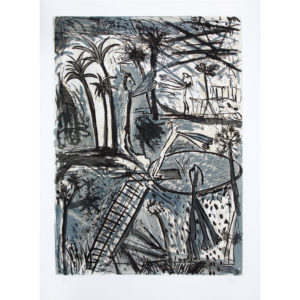Cane, Louis
Louis Cane is a contemporary French painter and sculptor, born on December 13, 1943 in Beaulieu-sur-mer (Alpes-Maritimes).
Read the biography
Displaying 1-12 of 13 resultsSortedfrom newest to oldest
-

St George and the dragon
Louis Cane
600€
-

Crucifixion II (White size)
Louis Cane
400€
-

Crucifixion II 1st version
Louis Cane
400€
-

Landscape to scale. Gray, blue, beige, black version
Louis Cane
600€
-

Ochre landscape
Louis Cane
750€
-

Pool and crane II
Louis Cane
550€
-

Landscape of Little Africa II
Louis Cane
750€
-

Scaled landscape (black-yellow version)
Louis Cane
600€
-

Landscape at scale
Louis Cane
600€
-

Two women II
Louis Cane
600€
-

Two women I
Louis Cane
600€
-

Crucifixion II 2nd version
Louis Cane
SOLD
Biography of Louis Cane
Louis Cane is a contemporary French painter and sculptor, born on December 13, 1943 in Beaulieu-sur-mer (Alpes-Maritimes).
À partir de 1961, il se forme à l'École nationale des Arts Décoratifs à Nice, puis à Paris. Dès ses premières œuvres, il interroge l’art : il présente en 1967-1968 au Hall des Remises en Question une toile recouverte sur toute sa surface d’un cachet-tampon marqué « Louis Cane artiste peintre ». En 1970, ses expérimentations formelles l’amènent à rejoindre le groupe Supports/Surfaces, constitués d’artistes qui interrogent le concept d’œuvre d’art en sortant l’œuvre de la toile sur châssis. Louis Cane diversifie ainsi les matériaux et les espaces : plastique, grillage, bois… Il compose sur la terre, les rochers ou encore l’environnement urbain.
1971 est une année d’importance dans la vie et l’œuvre de Louis Cane. C’est l’année où paraît la revue, Peinture, cahiers théoriques, dont Cane est l'un des fondateurs. Parallèlement, il réalise ses premières expositions personnelles à Paris (à la galerie Daniel Templon et à la galerie Yvon Lambert) et participe à la deuxième et troisième exposition du groupe Supports/Surfaces, dans un moment où les divergences s’accentuent au sein du groupe.
Pendant quelques années, Cane reste un peintre de l’abstraction : des séries des toiles sans châssis de 1970, étalées sur le sol, puis peintes par vaporisation et pliées en deux avant d’être découpées et agrafées directement sur le mur, il passe aux séries Sol/Mur de 1974-1975 : des toiles noires saturées de couleur par pulvérisation.
But in the years that followed, his work was marked by the influence of his travels.
De 1973 à 1978, il séjourne fréquemment en Italie, observe longuement les fresques de Raphaël au Vatican et étudie la peinture classique, celle de Cimabue et de Giotto notamment. Il continue ses séries abstraites jusqu’en 1975, mais son œuvre va effectuer un retour progressif à la figuration. En effet, vers 1975-1976, sa peinture se fait semi-abstraite grâce à des réinterprétations de grands chefs d’œuvres ; il réalise notamment des dessins des Ménines.
In 1977, he was included in the exhibition "L'avant-garde 1960-1976: trois villes, trois collections", which featured most of the artists of the Supports/Surfaces movement. In 1978, Cane made an even more marked return to figuration. His analysis of the history of pictorial forms led him to revisit emblematic figures such as Annunciations, Lunches on the Grass, Disembowelments, Crucifixions... through bold painting tinged with irony. At the same time, he began to devote himself in earnest to sculpture, which had been present in the background since his apprenticeship.
Dès les années 70, la rigueur de sa démarche artistique fait de lui un artiste à la renommée croissante. Ses œuvres sont régulièrement exposées dans de nombreux pays et voyagent dans les lieux les plus prestigieux : Centre Georges Pompidou à Paris, Château de Chambord, Musée d’Art Moderne de Sao Paulo, Fondation Maeght à Saint-Paul-de-Vence, exposition L’Esprit Supports/Surfaces au Musée d’Histoire du Shaanxi à Xi’an en Chine.
Throughout his life, Cane has reinvented supports, materials and aesthetics. In recent years, furniture design, which has been part of his training since his studies at the École des Arts Décoratifs, has become an important part of his work.
Les gravures proposées par la Galerie Arenthon témoignent de ses explorations formelles, par la réinterprétation de thèmes traditionnels, notamment celui de la crucifixion, un trait vif résolument moderne et une palette souvent monochrome, qui floute les frontières de l’abstrait et du figuratif.
Louis Cane s'éteint le 3 novembre 2024 à Paris.